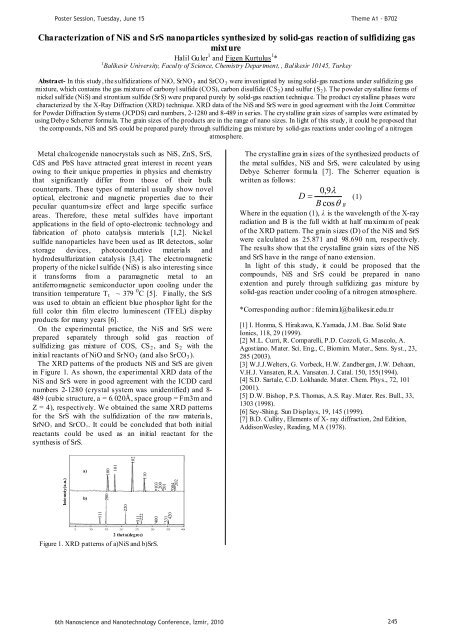Photonic crystals in biology
Photonic crystals in biology
Photonic crystals in biology
You also want an ePaper? Increase the reach of your titles
YUMPU automatically turns print PDFs into web optimized ePapers that Google loves.
Poster Session, Tuesday, June 15<br />
Theme A1 - B702<br />
Characterization of NiS and SrS nanoparticles synthesized by solid-gas reaction of sulfidiz<strong>in</strong>g gas<br />
mixture<br />
Halil Guler 1 and Figen Kurtulus 1 *<br />
Balikesir University, Faculty of Science, Chemistry Department, , Balikesir 10145, Turkey<br />
1<br />
Abstract- In this study, the sulfidizations of NiO, SrNO 3 and SrCO 3 were <strong>in</strong>vestigated by us<strong>in</strong>g solid-gas reactions under sulfidiz<strong>in</strong>g gas<br />
mixture, which conta<strong>in</strong>s the gas mixture of carbonyl sulfide (COS), carbon disulfide (CS 2 ) and sulfur (S 2 ). The powder crystall<strong>in</strong>e forms of<br />
nickel sulfide (NiS) and strontium sulfide (SrS) were prepared purely by solid-gas reaction technique. The product crystall<strong>in</strong>e phases were<br />
characterized by the X-Ray Diffraction (XRD) technique. XRD data of the NiS and SrS were <strong>in</strong> good agreement with the Jo<strong>in</strong>t Committee<br />
for Powder Diffraction Systems (JCPDS) card numbers, 2-1280 and 8-489 <strong>in</strong> series. The crystall<strong>in</strong>e gra<strong>in</strong> sizes of samples were estimated by<br />
us<strong>in</strong>g Debye Scherrer formula. The gra<strong>in</strong> sizes of the products are <strong>in</strong> the range of nano sizes. In light of this study, it could be proposed that<br />
the compounds, NiS and SrS could be prepared purely through sulfidiz<strong>in</strong>g gas mixture by solid-gas reactions under cool<strong>in</strong>g of a nitrogen<br />
atmosphere.<br />
Metal chalcogenide nano<strong>crystals</strong> such as NiS, ZnS, SrS,<br />
CdS and PbS have attracted great <strong>in</strong>terest <strong>in</strong> recent years<br />
ow<strong>in</strong>g to their unique properties <strong>in</strong> physics and chemistry<br />
that significantly differ from those of their bulk<br />
counterparts. These types of material usually show novel<br />
0,9<br />
optical, electronic and magnetic properties due to their<br />
D <br />
peculiar quantum-size effect and large specific surface<br />
B cos<br />
B<br />
areas. Therefore, these metal sulfides have important<br />
applications <strong>in</strong> the field of opto-electronic technology and<br />
fabrication of photo catalysis materials [1,2]. Nickel<br />
sulfide nanoparticles have been used as IR detectors, solar<br />
storage devices, photoconductive materials and<br />
hydrodesulfurization catalysis [3,4]. The electromagnetic<br />
property of the nickel sulfide (NiS) is also <strong>in</strong>terest<strong>in</strong>g s<strong>in</strong>ce<br />
it transforms fro m a paramagnetic metal to an<br />
antiferromagnetic semiconductor upon cool<strong>in</strong>g under the<br />
transition temperature Tt<br />
~379 0 C [5]. F<strong>in</strong>ally, the SrS<br />
was used to obta<strong>in</strong> an efficient blue phosphor light for the<br />
full color th<strong>in</strong> film electro lu m<strong>in</strong>escent (TFEL) display<br />
products for many years [6].<br />
On the experimental practice, the NiS and SrS were<br />
prepared separately through solid gas reaction of<br />
sulfidiz<strong>in</strong>g gas mixture of COS, CS 2 , and S 2 with the<br />
<strong>in</strong>itial reactants of NiO and SrNO 3 (and also SrCO 3 ).<br />
The XRD patterns of the products NiS and SrS are given<br />
<strong>in</strong> Figure 1. As shown, the experimental XRD data of the<br />
NiS and SrS were <strong>in</strong> good agreement with the ICDD card<br />
numbers 2-1280 (crystal system was unidentified) and 8-<br />
489 (cubic structure, a = 6.020Å, space group = Fm3m and<br />
Z = 4), respectively. We obta<strong>in</strong>ed the same XRD patterns<br />
for the SrS with the sulfidization of the raw materials,<br />
SrNO 3 and SrCO 3 . It could be concluded that both <strong>in</strong>itial<br />
reactants could be used as an <strong>in</strong>itial reactant for the<br />
synthesis of SrS.<br />
The crystall<strong>in</strong>e gra<strong>in</strong> sizes of the synthesized products of<br />
the metal sulfides, NiS and SrS, were calculated by us<strong>in</strong>g<br />
Debye Scherrer formula [7]. The Scherrer equation is<br />
written as follows:<br />
(1)<br />
Where <strong>in</strong> the equation (1), is the wavelength of the X-ray<br />
radiation and B is the full width at half maximum of peak<br />
of the XRD pattern. The gra<strong>in</strong> sizes (D) of the NiS and SrS<br />
were calculated as 25.871 and 98.690 nm, respectively.<br />
The results show that the crystall<strong>in</strong>e gra<strong>in</strong> sizes of the NiS<br />
and SrS have <strong>in</strong> the range of nano extension.<br />
In light of this study, it could be proposed that the<br />
compounds, NiS and SrS could be prepared <strong>in</strong> nano<br />
extention and purely through sulfidiz<strong>in</strong>g gas mixture by<br />
solid-gas reaction under cool<strong>in</strong>g of a nitrogen atmosphere.<br />
*Correspond<strong>in</strong>g author : fdemiral@balikesir.edu.tr<br />
[1] I. Honma, S. Hirakawa, K.Yamada, J.M. Bae. Solid State<br />
Ionics, 118, 29 (1999).<br />
[2] M.L. Curri, R. Comparelli, P.D. Cozzoli, G. Mascolo, A.<br />
Agostiano. Mater. Sci. Eng., C, Biomim. Mater., Sens. Syst., 23,<br />
285 (2003).<br />
[3] W.J.J.Welters, G. Vorbeck, H.W. Zandbergen, J.W. Dehaan,<br />
V.H.J. Vansaten, R.A. Vansaten. J. Catal. 150, 155(1994).<br />
[4] S.D. Sartale, C.D. Lokhande. Mater. Chem. Phys., 72, 101<br />
(2001).<br />
[5] D.W. Bishop, P.S. Thomas, A.S. Ray. Mater. Res. Bull., 33,<br />
1303 (1998).<br />
[6] Sey-Sh<strong>in</strong>g. Sun Displays, 19, 145 (1999).<br />
[7] B.D. Cullity, Elements of X- ray diffraction, 2nd Edition,<br />
AddisonWesley, Read<strong>in</strong>g, MA (1978).<br />
<br />
100<br />
311<br />
222<br />
110<br />
331<br />
420<br />
400<br />
200<br />
220<br />
102<br />
a)<br />
b)<br />
111<br />
101<br />
103<br />
201<br />
200<br />
004 202<br />
2 theta(degree)<br />
Figure 1. XRD patterns of a)NiS and b)SrS.<br />
6th Nanoscience and Nanotechnology Conference, zmir, 2010 245













